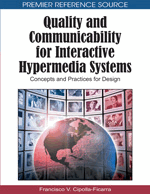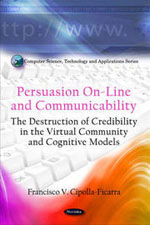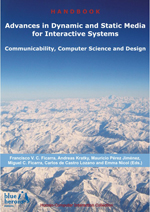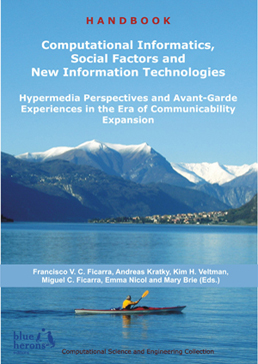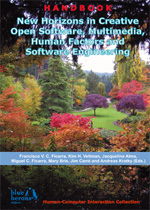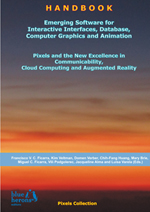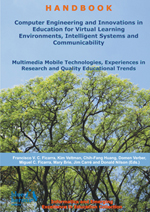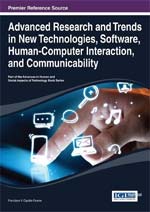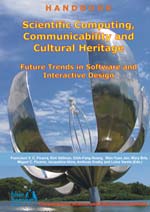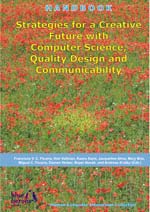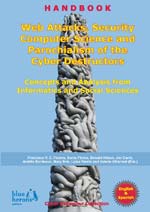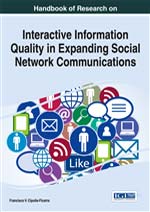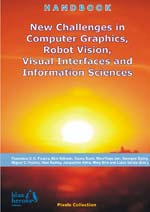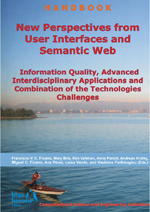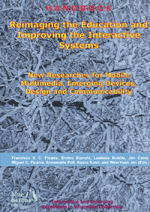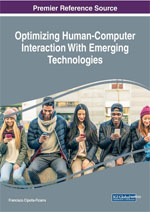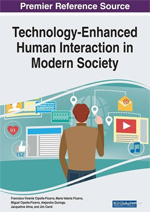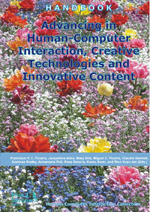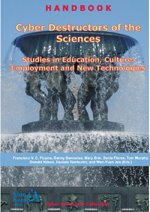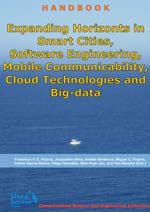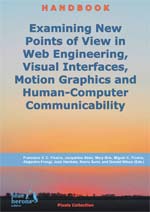Interaction Techniques and Technologies Applicable to Learning and Teaching: Changing Relations between New Media, Users, Contents and Evaluation of Interactive Systems
:: HCI Collection ::
:: Revised Selected Chapters ::
Main Editor: Francisco V. C. Ficarra
Co-editors: Jacqueline Alma (Vancouver, Canada), Mary Brie (La Valletta, Malta), Miguel C. Ficarra (Spain and Italy), Alejandra Quiroga (Sydney, Australia), Kauru Sumi (Hakodate, Japan), Wen-Yuan Jen (Miaoli, Taiwan), and Luisa Varela (Perpignan, France)
Editorial Assistants: Amélie Bordeaux (Lyon, France) and Donald Nilson (Oslo, Norway)
Book Details
• ISBN: 10979-12-80096-00-5 :: DOI: 10.979.1280096/005
• Publisher: Blue Herons Editions
• Location: Italy (Bg)
• Subjects: Education, Communicability, Enculturation, Web, Robotics, e-Learning, C++, AI
• Subjects: Computer Science, Interface, Big Data, Semiotics, Social Networks, Pedagogy
• Subjects: 3D Vision, Smart City, Q#, Biomaterials, Electron Microscopes, Microblogging
• Subjects: Semiotics, Computer Animation, 3D Printing, Transculturation, Ecology, Quality
• Subjects: Software, Hardware, Pluralistic Walkthroughs, Primary School, Domotics, Blog
• Subjects: Campus Virtual, Healthcare, Pandemic, CSCL, Machiavellism, HCI, Racism, VR
• Subjects: Sociology, Statistics, Storytelling, Pig-Sociocracy, Video Games, Narcisism, UX
• Subjects: Quantum Computing, Interactive Design, Shared Images, Automation, ICT, UCD
• Subjects: Assessment, IBM, QCL, Chemistry, Linguistics, Urban Planning, Java, AR, MR
• Subjects: Computer Graphics, JavaScript, Knowledge, Multimedia, IoT, Discourse, Analysis
• Subjects: Environment, Sustainability, Medical Visualization, New Media, Neo-Slaves, R&D
• Copyright: 2020
• Collection: Human-Computer Interaction
• Series volume: V
• Publication date: December, 2020
• Binding: Paperback
• Grade level: General
• Language: English
• Illustrations: Yes
• Colour: Yes
• Pages: 247
• Dimensions: 11.41x8.26x0.59 in. 1.39 lbs. :: 290x210x15 mm. 630 gr.
Preface
Those who control the present, control the past and those who control the past control the future.
George Orwell (1903 – 1950)
Currently there is a wrong tendency to bring together all the disciplines derived from the formal and factual sciences in the human-computer interaction (e.g., user experience, user-centred design, interaction design and children) and software / information technology (e.g., cloud computing, big data, computing systems, informatics), that is, electronic, industrial, nuclear, ... engineers / bachelors, foreign literature, mathematics, physics, anthropologists, fine arts, and a long etcetera.
One of the sectors that is the most harmed in this epistemological deviation of the sciences in the last quarter of a century is and will remain to be the third level educational sector, that is, the university. Particularly the future generations of professionals for the creation of novel interactive contents in keeping with the context, as well as the use and dissemination of the ICTs. Therefore, one of the main goals for this handbook is to establish what technologies are valid in the learning and teaching process, depending on where the final user, that is, professor or student, has been included.
Simultaneously, to investigate the influence of the new means of social communication, especially social networks, in the process of enculturation and transculturation. Another of the priority goals is the analysis of the methods and techniques used to evaluate this process between the computer user and the multimedia / AR (augmented reality) / MR (mixed reality) / VR (virtual reality) contents, from the design of the interactive systems to the final version of the same, having gone previously through the test phase and possible corrections.
In short, it aims to examine all those positive aspects that derive from the use of the new technologies in the teaching-learning process, and that can be enhanced through the evaluation techniques applied to software and hardware. Some of the submissions focused on areas related to education, virtual classroom, pedagogy linked with e-Learning, virtual worlds, video games, computer animation, interactive design, multimedia mobile computing, programming, web-based tools for education, human-computer communicability, human-computer interface, human-robot/automation interaction, software quality, heuristic evaluation, ethics of persuasive technology, etc., and related disciplines.
In this fifth handbook of "Human-Computer Interaction Collection", each of the keywords, paradigms, models, methods, results, tables, figures, conclusions, lessons learned and future lines of research, for example, aim to be a valid guide for students, teachers, researchers, education managers, programme coordinator, lab directors, university rectors, among other professionals in the third decade of the new millennium. Furthermore, the studies collected in the handbook have been evaluated and corrected prior to publication in an anonymous way by an international scientific committee. In some cases, these current research studies have been put forward orally –papers, short papers, research-in-progress, posters, and so on, with their corresponding demos. In other words, 45 – 75 minutes for an oral presentation –including time for questions, in other words, accompanied with practical / theoretical research works in international events.
The international conferences, workshops and symposiums are: ADNTIIC (International Conference on Advances in New Technologies, Interactive Interfaces and Communicability), CCGIDIS (International Symposium on Communicability, Computer Graphics and Innovative Design For Interactive Systems), ESIHISE (International Conference on Evolution of the Sciences, Informatics, Human Integration and Scientific Education), HCIHEART (International Conference on Human-Computer Interaction, High Education, Augmented Reality and Technologies), HCITISI (Argentine Conference on Human-Computer Interaction, Telecommunications, Informatics and Scientific Information), HCITOCH (International Workshop on Human-Computer Interaction, Tourism and Cultural Heritage), HIASCIT (International Conference on Horizons for Information Architecture, Security and Cloud Intelligent Technology), ITSIGUI (Innovation in Tourism Systems, Intelligent Gamification and User Interaction), MSIVISM (International Conference on Multimedia, Scientific Information and Visualization for Information Systems and Metrics), QUITANS (International Conference on Quantum Information Technologies Applied to Nature and Society), RDINIDR (International Conference on Research and Development in Imaging, Nanotechnology, Industrial Design and Robotics), and SETECEC (International Conference on Software and Emerging Technologies for Education, Culture, Entertainment, and Commerce). Finally, this short introduction provides a little summary of the chapters, showing their main contributions:
The central axis of the chapter “Verbum Mentis in Teaching and Learning: Analysis of Discourse” is established through the Latin notion of “verbum mentis” and the acoustic (homophones) and expressive meaning, in the colloquial language of some geographic areas of the south of the American continent, of the term “mentis”, whose meaning in Castilian is a kind of exclamation and affirmation that someone “lies.” That is to say, there is also a homography opposed to the notion of “mind”, which is normally assigned to it in Latin. The work is composed of a set of cases, a method for the analysis of the “neocolonizing discourse" and the corresponding results from the point of view of linguistics, semiotics, sociology and interactive communication. The corpus for discourse analysis comes from new media and free access online. This first analysis, with its corresponding method, includes not only the content, but also the person who creates that content and the context in which it is immersed. In addition, the “neocolonizing” historical framework is reconstructed and an attempt is made to establish the manifest or latent purposes of the content in the learning and teaching process. A process that is directly or indirectly related to new technologies, DH (digital humanities), and social communication. In short, the evolution of professional training, job opportunities and the generation of interhuman networks, which tend to persist over time. Finally, a selection of figures has been incorporated into the present study by Francisco V. C. Ficarra, to facilitate the understanding of the elaboration of the method used, the results obtained from the analysis carried out and future investigations.
Seung Heui Kim and Sun Young Kang the authors of the research: “Gamification and e-Learning Methodologies in Robotics: A Systematic Evaluation with Advanced Artificial Intelligence Systems.” It is an study that combines advanced theories of artificial intelligence applied to robotics and intelligent online systems, aimed at distance education and gamification. All this with automatic mechanisms of the evaluation process, which guarantee a qualitative, free and continuous service (24 hours a day, 7 days a week), in the teaching-learning cycle. Some of the keywords are: training courses, intelligent behavior, mobile robots, automatic evaluation, machine learning, design, and programming. The authors have resorted to a technique of the local culture, called: “reverse-puzzle” (first detect the pieces or minor problems, and gradually increase the degree of complexity) to solve the various components of the evaluative system. The authors have been developing, controlling and correcting various modules of the automatic evaluative method. Once it has shown excellent results for distance education, it has been definitively integrated and united. The present methodology has become a model to follow in research centers, where students and teachers develop prototypes of domestic robots. Lastly, the implementation of new and varied algorithms should be noted, whose comparative results with the state of the art, are presented in the tables and graphs, which accompany the conclusions of the research work.
The author of the work titled “Signs of Educational Deformations in HCI and Gamification” is Claudia Dohlich. She presents us with the main problems derived from the abusive use of certain social network applications (Facebook, Instagram and Twitter) that impair attention for mathematics in adolescent students who wish to continue their studies in engineering. Claudia Dohlich also raises the issue of the lack of coordination between gamification and hci. In this sense, she analyzes the breadth of issues that are currently addressed from these disciplines and the superficiality of the conclusions observed in the Spanish scientific-educational literature, from 2000 to the present day. The aim pursued by the author is to correct the errors detected in the HCI and gamification relationship, which exist in the scientific literature (final degree projects, master's thesis and doctoral thesis in Spain), in the last decade. The corpus of analysis related to the Spanish scientific-educational literature is very broad. The research work confirms a critical position towards these studies that show the presence of continuous circles that repeat conceptual errors in the publications. This criticism allows her to establish a series of hypotheses, which have been verified in several empirical studies.
In the chapter “Building a Bridge between HCI, AI and Quantum IT from the Perspective of Introductory Computing Education” the authors –Helen Roy, Charlotte Brown, Mark Tremblay, and Liam Lee– present a detailed and complete state-of-the-art on the potential of quantum computing / information technology (IT), human-computer interaction (HCI) and artificial intelligence (AI), potentially applicable to the IBM Q network. The authors argue some of the main theoretical advantages in the interaction of human beings with quantum computing and more specifically, in the context of IoT (Internet of Things). Simultaneously, they present the theoretical bases of several cognitive models and the results obtained from a first prototype of an intelligent tutor for the robotics industry, used in several distance learning centers, distributed in Asia and California. Before the conclusions, the first results in prototypes of smart objects made by students of the last courses of mechatronics and nanotechnology engineering are presented.
Enrico Bianchi is the author of the research entitled “Quantum Internet: The Best Programming Languages to Learn.” In it, he explains the main reasons why young computer scientists should be interested in quantum computing as a reliable job opportunity with a broad career future. These considerations are explained.It tries to summarize a way to follow in order to gradually learn languages such as C, C++, C#, Java, JavaScript, PHP, etc., until reaching the first quantum languages such as QCL, Q, and Q# (Microsoft). Some of the main and secondary themes that he addresses in this evolutionary process within the chapter for progressive learning in the “Quantum Internet” are: new paradigms for quantum programming, quantum data types, abstract models for quantum computation, design and semantics of quantum programming languages, compilation of quantum programs, semantical methods in quantum information theory. Each of these sections is accompanied by examples, illustrations and additional references, which help and promote the didactic process.
In the study developed by Eirik Gandersen and titled “Students' Experiences in Chemistry on the Use of 3D Vision Technologies to Enhance Human-Computer Interaction”, the author investigates the pros and cons of using various techniques of three-dimensional vision in the teaching of organic chemistry. The study begins with the use of omnidirectional holeography (3D vision / 360 degrees) in a room with small groups of students. Another group attends traditional multimedia classes (Knovio was the application used for the development of the lessons) in the Technology Vision Laboratory, using a computer, connected to a video projector. In both cases, the sections with the students have been recorded. Subsequently, the augmented reality of smartphones has been used to bolster the knowledge acquired individually. A series of questionnaires and tests to evaluate the knowledge received in different contexts has made it possible to collect the data of the students, once the lessons have been completed. The results obtained point to a better predisposition of these students towards augmented reality.
“Web Design, Mobile and Multimedia Technologies in Smart Cities” is the title with which its author Yong Li, explains a novel technique to teach in the first architecture courses the growing importance of wireless sensory networks. The proposed aim is to generate intelligent, efficient environments, with a low cost and with little environmental impact, especially in the houses near the port areas. The experience of 18 years in Melbourne (Australia), has allowed him to develop and put into practice a series of educational courses ranging from web engineering to mobile multimedia programming, using the latest news in information technology, related with transport, home automation, energy saving and renewable energy sources. Yong Li relates the main advantages of developing a new perspective of conceiving the work, educational and housing environments of citizens within sustainability and respect for the environment. His study describes how there is an increase in the competitiveness of these cities in the global village, from the point of view of the quality of life of its inhabitants. In brief, it is an chapter where theory and practice are exceptionally combined. In this sense, there is an extensive bibliography for all readers interested in these topics.
“Conquest of the Desert with 3D Printed Building” is the title selected by Anna Parodi to describe the potential of 3D printers in the construction of rural houses in desert areas. This is a multidisciplinary research work since it includes among others the collaborators of engineering (civil, computer science, ecology and environment), degrees (sociology, urban planning, historical, cultural and natural heritage) and architecture. This is her first study by Anna Parodi to highlight the importance of 3D printing in areas where water is lacking for the construction of traditional houses. She argues that climate change is favoring rains in former desert areas of North Africa, for example, with great potential for agriculture-related activities, at an early stage. Therefore, according to this study, the ease of quickly building comfortable rooms would mean displacement of future inhabitants in uninhabited areas, without the need to emigrate to other continents. In other words, she explains innovative solutions to solve two basic human needs such as food and housing. Besides, several models of houses made with new 3D printing technologies are presented, in particular by the HP (Hewlett Packard) company.
The authors of the chapter “Advanced Biomaterials for Clinical Cardiovascular Applications” are Armanda Rivera and Silke Dötzel. In it, they carry out an extensive analysis of the biomaterials currently used in medicine, focusing on the specific cases of heart valves. Moreover, they have focused their studies on “ad hoc” software applications for three-dimensional visualization, in collaborative work groups, geographically distributed throughout the world. The content has a high didactic level and is structured as follows: overview, design principles (they have developed an intercultural style guide), analysis, results, discussion and final comments. In each of the sections there is a range of figures, graphs, and tables, to progressively explain the meticulous study carried out by the authors. In addition, the breadth of extension in the conclusions allows knowing not only the lessons learned, but also their impact for the establishment of future lines of research.
“Biotechnology and Coronavirus: Creating Strategic Partnerships in the Field of Quantum Information, Healthcare and Medical Visualisation” is the title chosen by Armanda Rivera and Silke Dötzel. They are the authors of this study that has been developed in the field of biotechnology and the new Covid-19 virus. A virus that has ended up unleashing the first pandemic of the new millennium. They focused on enhanced light microscopy visualization of virus particles. Furthermore, in this first work there is an extensive review of the scientific literature with regard to pandemics, biology and scientific visualization in electron microscopes from the 20th century to the present. The results obtained allow us to establish a first set of guidelines to establish new actions to follow in the fight against the current pandemic and those that will await us in the future. In this chapter, the authors carry out an important analysis of the evolution of scientific visualization in the medical field and computer graphics, especially in micro-visualization and the generation of image databases. Armanda Rivera and Silke Dötzel present a first prototype of databases to search for collaborators in the field of health, computer graphics and quantum computing.
The chapter “A Confederate Auditor System for Computer-Supported Collaborative Learning” shows the details of a new confederate audit system called “CLASSOS” (CLASSROOM SOS), in the case of emergencies or unforeseen events that paralyze the normal development of presential classes. The authors are Sabine Reisenauer and Claudia Dohlich. The purpose is the control and help in real time of the main agents involved in the CSCL (Computer-Supported Collaborative Learning) process. The work describes the audit mechanism implementing the detection of errors and possible solutions, depending on the profile of the agents, the didactic and technological resources at their disposal, the set of methods available for distance education, among many other.variables or components. The adjustments made to cover all levels of students are also disclosed, that is, elementary schools, passing through high schools or secondary institutes until reaching university students. The present chapter closes with an extensive record of results obtained from various evaluation techniques, as well as an extensive bibliography for all those interested in continuing to contribute new modules to the system, related to the CSCL.
With the title “Distance Education, Population Disorientation and Technological Lies in Times of Pandemic: The Case of Salamanca”, its authors, Ricardo Fraile Rojas, Inés Tejedor Martín, Juana Cruz Arevalo, Mirta De La Fuente Palacios, Luis Malmierca Hernández, Raquel Rodríguez Porras, and Antonia Mata Palomero from Salamanca (Spain), describe how a large part of the population has had neither technological tools, nor pedagogical methods, nor sufficient citizen or university information (particularly, of all those dedicated to education / research and new technologies) to cope with distance education tasks from home, through the use of computers, video conferences systems, and so forth. The research begins with a state of the art of the lack of didactic resources (didactic content, educational software, review material, etc.) to face the pandemic, in one of the Spanish regions most affected by Covid-19, in 2020. Consequently, they expand this introduction with an inventory of publications of the University of Salamanca (in annex format), where they detected an exorbitant and abnormal amount of research works, carried out to date, that does not adjust to the reality of the Castilla-Leon region, for example. They cite among many other examples: the lack of educational content for the different subjects (core, specific, electives, tutorials, and so on) or having to resort to software for telecommunications from the USA and the rest of Europe. There is a wide set of cases, collected at the beginning of the pandemic, where it is found that parents, students and teachers have not been able to successfully face education, resorting to new technologies. In addition, the authors explain to us how with the pandemic the digital divide has been overcome by a new abysmal rift between the university and the rest of the population. On the one hand there are university officials dedicated to research, teachers, administrative personnel, and so forth, on the other hand, and the rest of the population. In the latter, there are members who do not have a guaranteed fixed income for life but carry out educational activities. Faced with this lack of methodologies, didactic and technological resources, and an extensive etcetera, and in a national and international health emergency situation derived from the coronavirus, they have drawn up a universal manifesto so that in the immediate future local universities adjust their research to the reality of their communities, among many other proposals, which are listed in the lessons learned section.
The authors of the work called “New Media and Big Data: Analysing the Social and Economic Impact of Covid-19” are Marta Romero, Isabelle Bernard and Rémi Dupré. This research and development project begins with a state of the art of new media, a brief evolution of them as sources of information and the interrelation with big data. The authors developed the first prototype of an app to catalog the degree of reliability of online information sources, automatically eliminating all those that are in the range of fake news. Then, they reveal the main objectives of the research project as well as other objectives such as the analysis and forecasting of some of the economic and social effects derived from Covid-19. In this sense, they have developed an interactive system that compares and establishes links with the existing data from the 2008 financial crisis. Besides, they present a projection methodology on the first economic and social effects derived from the virus. Since the beginning of the pandemic in Asia, America and Europe, they have been storing statistical data of the evolution in the social networks, focusing their work on the official bulletins of the health departments. Public entities that are located in the geographical area of the EU and the UK. The first tables with their corresponding results, which accompany this chapter, facilitate understanding of the magnitude of this project.
In this research “Interfaces and Users: A Study of Best Practices”, its authors Anna Parodi and Enrico Bianchi, present us with the results of interfaces made for domestic robots in various industries in Southeast Asia, Australia and Europe. The period of time in which the research has been developed goes from 2011 to 2019, inclusive, with the elderly as potential user. They have concentrated their studies on the faces of the characters and very specifically on the various expression systems, based on the first studies carried out by Ekman in 1972. Studies that refer to universal facial expressions. The authors have adapted them to their own set of expressions as a result of their research in the robotics industry. In the realization of this set they have used various evaluation techniques of the users, such as: pluralistic walkthroughs, cognitive walkthroughs, consistency inspections, among others, before making the prototypes for finite state automata of the face manager module. In this research work we can see the variety of modules that they have developed over time and based on the experiments carried out, to allow the designer a high level of abstraction of the complexity of the elements that make up the face.
“Is It Necessary to Include Lessons on the Use of Social Networks in Primary Schools?” This rhetorical question used as the title of the chapter by its authors (Carla Pereira Silva, Mario Brito Vidal, Luciana Felgueiras Vasconcelos, Felipe Beltrão Torres, and Laura de Moura Pinho), highlights the rise of the need to include weekly lessons with regard to social networking, in private institutions (read religious and elitist) in São Paulo (Brazil). These authors show how children have access to the use of smartphones, in their breaks in the cafeteria. In those moments outside the classroom, they preferred to visit the contents of social networks (videos and music, mainly), instead of communicating or playing with their classmates, in the courtyard. Based on these observations, several “field research” projects were carried out, with specialists from the faculties of education, anthropology, psychology and computer science of several Brazilian universities, the results of which were transmitted to the council of teachers and the representatives of the parents. The work explains the motivations for which, progressively, interactive digital content has surpassed traditional study books (paper support), in these educational institutions, located in the main Brazilian cities. Consequently, a division is generated between “apocalyptic” and “integrated”, as Umberto Eco would say. A division that leads the experts consulted and the teachers of the primary education (added to the consent of the children's parents), to the need to include the study of social networking, in the child population, whose ages range from 7 - 9 years.
In the present work, "Storytelling and Fake Transformation of Telecommunications Engineer in Catalonia: From Modern Slavery Education, Camouflaged Racism and Ultranationalism To e-Billing Travel (Un)Happiness, (Un)Conscious Capitalism and (Pig)Sociocracy", a new version of storytelling in ICTs (information and communication technologies) and university education is used by eliminating the persuasive aspect of the story and using true and verifiable events. The research modifies the objective of manipulative communication in storytelling to reveal Machiavellian characters, places, and behaviors that do not change over time, in contexts related to the new technologies, private education, and the workplace. The techniques of these terrorists of the sciences and innovative knowledge are also exposed to adapt quickly to the passing fads in ICTs and to be omnipresent in the traditional media and new media (newspapers, radio, television, blog, microblogging, shared images, etc.). In addition, the stratagems of these narcissistic psychopaths in capturing "neo-slaves in new technologies" are indicated. That is, practically free labor for their business / educational networks, and simultaneously humiliated and degraded by camouflaged xenophobia and pseudo-ultra nationalism. Conclusively, the author of the study –Francisco V. C. Ficarra– shows how they deform the workplace and educational ICTs market, in times of crisis, resorting to notions such as job happiness, conscious capitalism and sociocracy in Bacelona (Catalonia - Spain).
Finally, we want to make a very special clarification. Many of the research works have been presented orally at various international events (presential or virtual). The interesting open debate after the masterful explanations of their authors has served so that they and all those interested in the topics presented receive constructive feedback on their contributions. In other cases, we are dealing with the latest contributions from some of our colleagues, who, due to the pandemic, are no longer with us. To all of them and their loved ones we offer our sincere expressions of affection for the good times shared and all the teachings received. We will try to follow the path that they have traced for us in the best possible way and as always, trying to silently overcome and resist the eternal unsavoury characters who have had fun for decades and decades, being a nuisance, mocking and putting the cane between the wheels, of our modest but honest chariot.
Francisco V. C. Ficarra
San Pellegrino Terme, Italy (December 2020)
Partial Content On-line (pdf format)
• Front Cover (here)
• Preface :: Acknowledgment (here)
• Chapters :: Final Remarks :: Author Index :: Keywords Index :: References ... (here)
• Back Cover (here)
Additonal Handook Info
• Only paper copy – no digital book on-line and/or off-line –
• Special Price € 95 (expedition cost not included) ... e-Commerce :: Info Form
Welcome to Blue Herons Editions!
The origin of this publishing project is to be found in the Canadian lands, where nature presents itself generous in many places of its wide geography. More ...
Education, Communicability, Design, Computer Science, HCI, Computer Graphics and Computer Animation:
We focus on education and new technologies with 40 years long experience. More ...
Literature and Journalism:
Intersection between universal literature, local new journalism (true stories), sociology and legal immunity. Two collections:
- Casoncelli Bergamaschi
It is a typical bergamasque dough filled with meat, similar to the raviolis. More ...
- Menjar Blanc & Black
It is a typical sweet of the Catalan coast and the Balearic Islands. More ...
Others Releases:
See all others new releases in books, CD, DVD, etc. More ...

Call for Papers, Short Papers, Posters, Demos, Research-in-Progress, Workshops, Doctoral Consortium, Hardware & Software Companies - Didactic Demos Sessions ...
ADNTIIC 2020 :: HCITOCH 2020 :: SETECEC 2020 :: HIASCIT 2020 :: CCGIDIS 2020 :: IPCTIIC 2020 | HCITISI 2020 :: MSIVISM 2020 :: RDINIDR 2020 :: ESIHISE 2020 :: HCIHEART 2020 :: QUITANS 2020 :: ITSIGUI 2020


